|
The meerkat is a small, highly intelligent, sociable
burrowing mammal and is a member of the mongoose, rather than
cat family. This amusing animal derives its name from the
Dutch/Afrikaans for "lake-cat". Though it is native to
shrub-land deserts of southern Africa.

Compare
the Meerkat
The advertisements run by 'comparethemarket.com' to do with
insurance, have raised the profile of these adorable creatures.
The adverts are particularly amusing, telling the tale of a
Russian meerkat and his struggle to draw attention to his
website about other meerkats.
The meerkat or suricate
(Suricata suricatta) is a small mammal belonging to the mongoose family. Meerkats live in all parts of the Kalahari Desert in Botswana, in much of the Namib Desert in Namibia and southwestern Angola, and in South Africa. A group of meerkats is called a "mob", "gang" or "clan". A meerkat clan often contains about 20 meerkats, but some super-families have 50 or more members. In captivity, meerkats have an average life span of 12–14 years, and about half this in the wild.
The name "meerkat" has a Dutch origin but by misidentification. Dutch meerkat refers to the "guenon", a monkey of the Cercopithecus genus. The word "meerkat" is Dutch for "lake cat", but the suricata is not in the cat family, and neither suricatas nor guenons are attracted to lakes; the word possibly started as a Dutch adaptation of a derivative of
the Sanskrit markaţa
= "monkey", perhaps in Africa via an Indian sailor on board a Dutch East India Company ship. The traders of the Dutch East India Company were likely familiar with monkeys, but the Dutch settlers attached the name to the wrong animal at the Cape. The suricata is called stokstaartje = "little stick-tail" in Dutch.
According to African popular belief (mainly in the Zambian/Zimbabwean region), the meerkat is also known as the sun angel, as it protects villages from the moon devil or the werewolf which is believed to attack stray cattle or lone tribesmen.
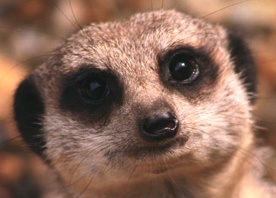
Anatomy
The meerkat is a small diurnal herpestid (mongoose) weighing on average about 731 grams (1.61 lb) for males and 720 grams (1.6 lb) for females. Its long slender body and limbs give it a body length of 25 to 35 centimetres (9.8 to 14 in) and an added tail length of 17 to 25 centimetres (6.7 to 9.8 in). Its tail is not bushy like all other mongoose species, but is rather long and thin and tapers to a black or reddish colored pointed tip. The meerkat uses its tail to balance when standing upright, as well as for signaling. Its face tapers, coming to a point at the nose, which is brown. The eyes always have black patches around them and it has small black crescent-shaped ears that can close to exclude soil when digging. Like cats, meerkats have binocular vision, a large peripheral range, depth perception, and eyes on the front of their faces.
At the end of each of a meerkat's "fingers" is a non-retractable, strong, 2 centimetres (0.79 in) long, curved claw used for digging burrows and digging for prey. Claws are also used with muscular hindlegs to help climb trees. Meerkats have four toes on each foot and long slender limbs. The coat is usually fawn-colored peppered with gray, tan, or brown with a silver tint. They have short parallel stripes across their backs, extending from the base of the tail to the shoulders. The patterns of stripes are unique to each meerkat. The underside of the meerkat has no markings, but the belly has a patch which is only sparsely covered with hair and shows the black skin underneath. The meerkat uses this area to absorb heat while standing on its rear legs, usually early in the morning after cold desert nights.
Diet and foraging behaviour
Meerkats are primarily insectivores, but also eat lizards, snakes, scorpions, spiders, plants, eggs, small mammals, millipedes, centipedes and, more rarely, small birds. Meerkats are immune to certain types of venom;
unlike humans, they are immune to the very strong venom of the scorpions of the Kalahari
Desert. They have no excess body fat stores, so foraging for food is a daily need.
Meerkats forage in a group with one "sentry" on guard watching for predators while the others search for food. Sentry duty is usually approximately an hour
long. A meerkat can dig through a quantity of sand equal to its own weight in just
seconds. Baby meerkats do not start foraging for food until they are about 1 month old, and do so by following an older member of the group who acts as the pup's
tutor. The meerkat standing guard makes peeping sounds when all is well. If the meerkat spots danger, it barks loudly or whistles.
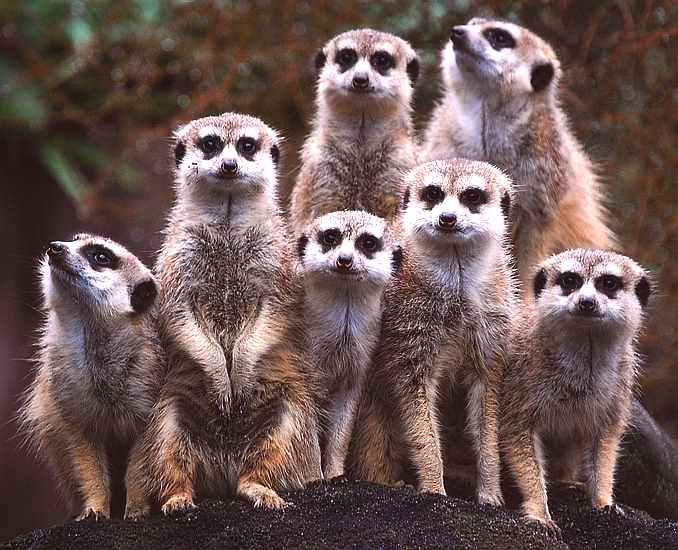
A meerkat family photograph
Reproduction
Meerkats become sexually mature at about one year of age and can have one to five pups in a litter, with three pups being the most common litter size. Wild meerkats may have up to four litters per year. Meerkats are iteroparous and can reproduce any time of the year but most births occur in the warmer seasons. The pups are allowed to leave the burrow at three weeks old. When the pups are ready to emerge from the burrow, the whole clan of meerkats will stand around the burrow to watch. Some of the adolescents might try to show off so they can have more attention than the pups.
There is no precopulatory display; the male ritually grooms the female until she submits to him and copulation begins, the male generally adopting a seated position during the act. Gestation lasts approximately 11 weeks and the young are born within the underground burrow and are altricial (undeveloped). The young's ears open at about 15 days of age, and their eyes at 10–14 days. They are weaned around 49 to 63 days. They do not come above ground until at least 21 days of age and stay with babysitters near the burrow. After another week or so, they join the adults on a foraging party.
Usually, the alpha pair reserves the right to mate and normally kills any young not its own, to ensure that its offspring has the best chance of survival. The dominant couple may also evict, or kick out the mothers of the offending offspring.
New meerkat groups are often formed by evicted females pairing with roving males.
If the members of the alpha group are relatives (this tends to happen when the alpha female dies and is succeeded by a daughter), they do not mate with each other and reproduction is by group females stray-mating with roving males from other groups; in this situation, pregnant females tend to kill and eat any pups born to other females.
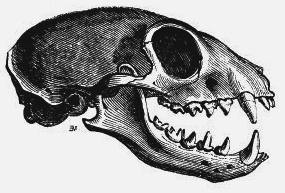
Skull and dentition
as illustrated in Gervais' Histoire naturelle des
mammifères
Behavior
Meerkats are small burrowing animals, living in large underground networks with multiple entrances which they leave only during the day. They are very social, living in colonies averaging 20–30 members. Animals in the same group regularly groom each other to strengthen social bonds. The alpha pair often scent-mark subordinates of the group to express their authority, and this is usually followed by the subordinates grooming the alphas and licking their faces. This behavior is also usually practiced when group members are reunited after a short period apart. Most meerkats in a group are all siblings or offspring of the alpha pair.
Meerkats demonstrate altruistic behavior within their colonies; one or more meerkats stand sentry while others are foraging or playing, to warn them of approaching dangers. When a predator is spotted, the meerkat performing as sentry gives a warning bark, and other members of the gang will run and hide in one of the many bolt holes they have spread across their territory. The sentry meerkat is the first to reappear from the burrow and search for predators, constantly barking to keep the others underground. If there is no threat, the sentry meerkat stops signaling and the others feel safe to emerge.
Meerkats also babysit the young in the group. Females that have never produced offspring of their own often lactate to feed the alpha pair's young, while the alpha female is away with the rest of the group. They also protect the young from threats, often endangering their own lives. On warning of danger, the babysitter takes the young underground to safety and is prepared to defend them if the danger follows. If retreating underground is not possible, she collects all young together and lies on top of them.
Meerkats are also known to share their burrow with the Yellow Mongoose and ground squirrel, species with which they do not compete for resources. If they are unlucky, sometimes they share their burrow with snakes.
Like many species, meerkat young learn by observing and mimicking adult behaviour though adults also engage in active instruction. For example, meerkat adults teach their pups how to eat a venomous scorpion: they will remove the stinger and help the pup learn how to handle the
creature.
Despite this altruistic behaviour, meerkats sometimes kill young members of their group. Subordinate meerkats have been seen killing the offspring of more senior members in order to improve their own offspring's
position.
Meerkats have been known to engage in social activities, including what appear to be wrestling matches and foot races.
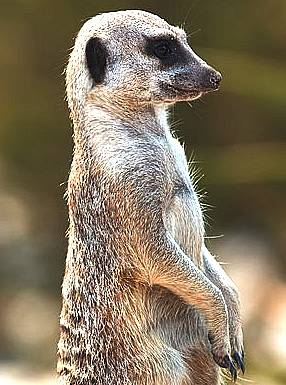
Vocalization
Meerkat calls may carry specific meanings, with particular calls indicating the type or the location of a predator. They chirrup, trill, growl, or bark, according to circumstances
. How these calls work is not yet clear.
Meerkat groups
A meerkat group may die out because of predator attack, its alpha pair being unable to breed, starvation due to drought, or epidemic disease.
A new meerkat group often arises from evicted females meeting and staying with roving males, seeking to mate. The litter size is usually 2–5 pups.
The size of the groups is variable. A group which becomes over-large may routinely have to disperse widely to find enough food when foraging. As a result, when suddenly needing to run for shelter, members of the group may choose different holes, resulting in the group fissioning.
Subspecies
There are three subspecies of
meerkat:-
Domestication
Meerkats make very poor pets. They can be aggressive especially toward guests and may bite. They will scent-mark their owner and the house (their "territory").
Meerkats
are the African cousins to the prairie dog and they are even
more fun to watch; so much fun that they even have their own
show on Animal Planet called Meerkat Manor. Don’t
worry if you haven’t seen the show, there’s a free episode
available on the iTunes
Store called Science
of Meerkats, and it’s pretty good.
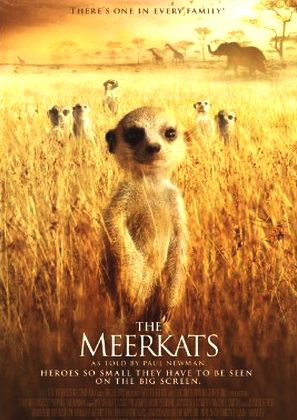
The
Meerkats - film poster
The Meerkats is a feature-length 2008 British wildlife fiction film which anthropomorphises the daily struggles of a clan of meerkats in the Kalahari Desert. It was produced by BBC Films and The Weinstein Company, and filmed by the award-winning BBC Natural History Unit. It is the debut directorial feature of James Honeyborne, previously a producer of natural history programmes for television. The worldwide premiere was held at the Dinard Film Festival, France in October
2008, expanding to a wide release the following week. The film was released in 2009, on 7 August in the UK. A US date has not yet been announced.
Production
The Meerkats was announced in November 2006 as BBC Films and The Weinstein Company agreed a co-financing deal for the film, with The Weinstein Company also handling international distribution. The year-long principal photography began on location in the Kalahari Desert, South Africa in the same
month. It became the Natural History Unit's first feature-length wildlife fiction based on original material, and followed the successes of Earth (2007) and Deep Blue (2003) which were both companion pieces to BBC television series. The script was written by Alexander McCall Smith, author of many books set in Botswana. Paul Newman provides the narration, which was recorded at a studio near his home shortly before his death. The Meerkats is believed to be one of the last film credits of his long
career.
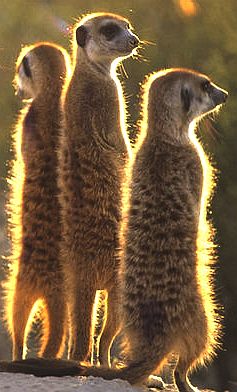
Meerkat Manor:
The Story Begins, a second feature-length wildlife film on meerkats, was also released in 2008. It was produced by Animal Planet, Discovery Films and Oxford Scientific Films, the makers of Meerkat Manor, but was not screened in theatres. BBC Films' Joe Oppenheimer, a producer of The Meerkats, has stated that the two films are very different in character (the BBC and Discovery originally planned to collaborate, but couldn't agree on a common ground). James Honeyborne has described The Meerkats as "a stand-alone, blue-chip wildlife film from the ground up. It will be immersive. There will be a huge sense of place on a massive scale. You will really see real wild
animals."
Reception
Writing in The Guardian reviewer Philip French noted that the "... nature movie made in the Kalahari desert has some good footage but is more Disney-anthropomorphic than
Attenborough-authentic."
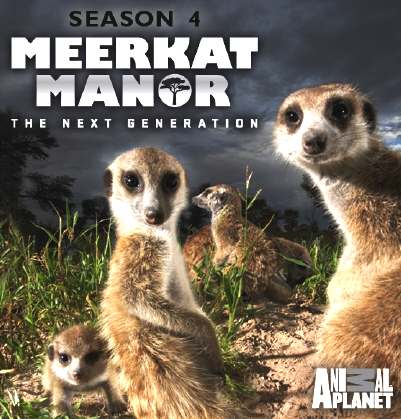
LINKS:
Festival
screens Newman swansong" BBC Online 2008-10-05 http://news.bbc.co.uk/1/hi/entertainment/7653429.stm
"The
Meerkats: BBC Films and the BBC Natural History Unit
collaborate on ambitious first feature film" BBC
Press Office 2006-11-01 http://www.bbc.co.uk/pressoffice/stories/2006/11_november/01/meerkats.shtml
"French
film festival to show Paul Newman’s last work"
Enjoy France News 2008-10-06
http://www.enjoyfrance.com/content/view/1697/31/
"After
a Run of Penguin Chic, It’s the Year of the Meerkat"
New
York Times http://www.nytimes.com/2006/12/17/movies/17lyon.html
"The
Meerkats" The
Guardian http://www.guardian.co.uk/film/2009/aug/09/meerkats-film-review
Official
BBC website
The
Meerkats at the Internet
Movie Database
The
Meerkats at Rotten
Tomatoes
Suricata
suricatta 2008 IUCN Red List of Threatened Species
http://ladywildlife.com/animals/meerkat.html
Mighty
Masked Meerkat Mobs
"Teaching
in Wild Meerkats" 10.1126/science.1128727 16840701
http://www.sciencemag.org/cgi
Murderous
Meerkat Moms Contradict Caring Image, Study Finds
"Vocalize
to localize: A test on functionally referential alarm
calls" Interaction Studies 5
10.1075/is.5.3.02man.
http://www.ingentaconnect.com/content/
"Meerkat
Studbook Suricata suricatta North American Region"
(pdf). http://library.sandiegozoo.org/studbooks/carnivores/meerkat2003.pdf
2010-01-15
"Meerkat
adverts lead to surge in unwanted pets" bbc.com
2 June 2010 http://news.bbc.co.uk/local/cambridgeshire/hi/people_and_places/nature/.stm
http://www.meerkats.net/info.htm Meerkat
pups go to eating school BBC
News 13 July 2006
Animal
Diversity – Meerkat University
of Michigan
Meerkat
enquiries on the increase – BBC Nottingham
http://www.adoptameerkat.org.uk/
http://flickr.com/photo/
(Photo courtesy of)
Wikipedia
Animal lover
POPULAR
MAMMALS:
REFERENCE
and LINKS:
|
AMPHIBIANS |
Such
as frogs (class: Amphibia) |
|
ANNELIDS |
As
in Earthworms (phyla: Annelida) |
|
ANTHROPOLOGY |
Neanderthals,
Homo Erectus (Extinct) |
|
ARACHNIDS |
Spiders
(class: Arachnida) |
|
ARTHROPODS |
Crabs,
spiders, insects (phyla: Arthropoda) |
|
BIRDS
|
Such
as Eagles, Albatross
(class: Aves) |
|
CETACEANS
|
such
as Whales
& Dolphins
( order:Cetacea) |
|
CRUSTACEANS |
such
as crabs (subphyla: Crustacea) |
|
DINOSAURS
|
Tyranosaurus
Rex, Brontosaurus (Extinct) |
|
ECHINODERMS |
As
in Starfish (phyla: Echinodermata) |
|
FISH
|
Sharks,
Tuna (group: Pisces) |
|
HUMANS
- MAN |
Homo
Sapiens THE
BRAIN |
|
INSECTS |
Ants,
(subphyla: Uniramia class:
Insecta) |
|
LIFE
ON EARTH
|
Which
includes PLANTS
non- animal life |
|
MAMMALS
|
Warm
blooded animals (class: Mammalia) |
|
MARSUPIALS |
Such
as Kangaroos
(order: Marsupialia) |
|
MOLLUSKS |
Such
as octopus (phyla: Mollusca) |
|
PLANTS |
Trees
- |
|
PRIMATES |
Gorillas,
Chimpanzees
(order: Primates) |
|
REPTILES |
As
in Crocodiles,
Snakes (class: Reptilia) |
|
RODENTS |
such
as Rats, Mice (order: Rodentia) |
|
SIMPLE
LIFE FORMS
|
As
in Amoeba, plankton (phyla: protozoa) |
|
|
A
taste for adventure capitalists

Solar
Cola - a healthier alternative
|







